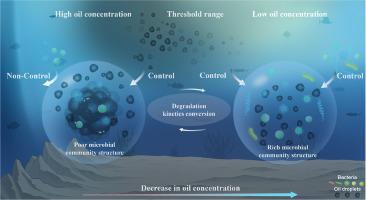石油浓度和微生物群落共同控制海洋溢油生物降解:紧急阈值效应重塑微生物修复策略
IF 12.4
1区 环境科学与生态学
Q1 ENGINEERING, ENVIRONMENTAL
引用次数: 0
摘要
生物降解在全球海洋溢油的补救中得到了广泛的研究和实施,降解速度是清理工作持续时间的一个关键因素。虽然不同的研究小组已经阐明了油脂浓度的关键影响,但微生物群落结构的作用却受到了有限的关注。在这里,我们利用综合化学和生物学分析(16S rRNA测序和亚转录组学)系统地表征了三种石油环境浓度(2 ppm, 20 ppm和200 ppm)下的生物降解模式和相关机制。结果表明,降解速率与油脂浓度成反比(R2 > 0.65)。进一步发现并阐明了低促高抑效应对溢油降解速率的影响。同时,我们确定了油浓度的阈值范围(101 ~ 102 ppm)。在此范围内,以变形菌门(相对丰度>; 63%)为主的微生物群落通过增强的基因表达和代谢途径主导降解。相反,微生物的主导作用被油浓度所取代。综上所述,微生物群落和油浓度共同影响溢油的生物降解。在此基础上,关键摘要预测了石油泄漏在几个月到几年的时间尺度上的行为命运。这些发现为设计基于溢油浓度范围的针对性生物修复方案提供了可行的见解。本文章由计算机程序翻译,如有差异,请以英文原文为准。

Oil concentration and microbial communities jointly control marine oil spills biodegradation: Emergent threshold effects reshaping microbial remediation strategies
Biodegradation has been extensively investigated and implemented in the remediation of global marine oil spills, with the rate of degradation being a critical factor in the duration of cleanup efforts. While various groups have elucidated the key impacts of oil concentration, the role of microbial community structure has received limited attention. Here, we utilized integrated chemical and biological analysis (16S rRNA sequencing and metatranscriptomics) to systematically characterize the biodegradation patterns and associated mechanisms at three oil environmental concentrations (2 ppm, 20 ppm, and 200 ppm). The results showed the degradation rate was inversely proportional to the oil concentration (R2 > 0.65). We further found and elucidated the effect of low-promotion-high-suppression effect on oil spill degradation rate. Meanwhile, we identified the threshold range of oil concentration (101 ∼ 102 ppm). Below the range, microbial communities dominated by the Proteobacteria phylum (relative abundance > 63 %) dominate degradation through enhanced gene expression and metabolic pathways. Conversely, microbial dominant roles are superseded by oil concentration. In conclusion, microbial community and oil concentration jointly influence oil spills biodegradation. Based on this, critical summaries predict the behavioral fate of oil spills on time scales ranging from months to years. These findings provide actionable insights for designing targeted bioremediation programs based on the range of oil spill concentrations.
求助全文
通过发布文献求助,成功后即可免费获取论文全文。
去求助
来源期刊

Water Research
环境科学-工程:环境
CiteScore
20.80
自引率
9.40%
发文量
1307
审稿时长
38 days
期刊介绍:
Water Research, along with its open access companion journal Water Research X, serves as a platform for publishing original research papers covering various aspects of the science and technology related to the anthropogenic water cycle, water quality, and its management worldwide. The audience targeted by the journal comprises biologists, chemical engineers, chemists, civil engineers, environmental engineers, limnologists, and microbiologists. The scope of the journal include:
•Treatment processes for water and wastewaters (municipal, agricultural, industrial, and on-site treatment), including resource recovery and residuals management;
•Urban hydrology including sewer systems, stormwater management, and green infrastructure;
•Drinking water treatment and distribution;
•Potable and non-potable water reuse;
•Sanitation, public health, and risk assessment;
•Anaerobic digestion, solid and hazardous waste management, including source characterization and the effects and control of leachates and gaseous emissions;
•Contaminants (chemical, microbial, anthropogenic particles such as nanoparticles or microplastics) and related water quality sensing, monitoring, fate, and assessment;
•Anthropogenic impacts on inland, tidal, coastal and urban waters, focusing on surface and ground waters, and point and non-point sources of pollution;
•Environmental restoration, linked to surface water, groundwater and groundwater remediation;
•Analysis of the interfaces between sediments and water, and between water and atmosphere, focusing specifically on anthropogenic impacts;
•Mathematical modelling, systems analysis, machine learning, and beneficial use of big data related to the anthropogenic water cycle;
•Socio-economic, policy, and regulations studies.
 求助内容:
求助内容: 应助结果提醒方式:
应助结果提醒方式:


